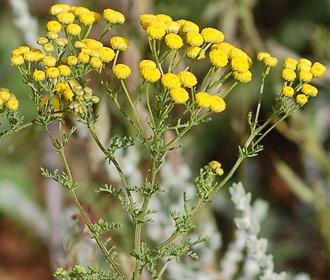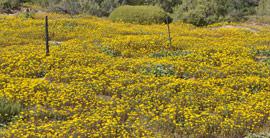Oncosiphon suffructicosum
Oncosiphon suffruticosum (L.) Källersjö
Family: Asteraceae
Common names: stinkingweed (Eng.); stinkkruid, wurmkruid, wurmbos, miskruid (Afr.); Calomba daisy (Australia), shrubby mayweed (USA).
Introduction
Oncosiphon suffruticosum is an aromatic annual with masses of bright yellow flower heads, and is an important Cape herbal medicine.

Description
Description
Oncosiphon suffruticosum is a strongly aromatic annual herb up to 50 cm tall. The leaves are finely divided, pinnatisect (divided feather-like to the midrib) and glabrous.
The flower heads are 4-6 mm in diameter, yellow, lacking in ray florets and arranged in dense corymbs (± flat-topped inflorescences in which the branches all reach about the same level). The involucral bracts (surrounding the flower heads) are glabrous. The florets are bisexual and four-lobed with a thickened floral tube. Flowering time is from September to December.
The fruits are small, brownish, four-ribbed and crowned with a small unequal-sided pappus of white scales. The fruits are non-myxogenic (do not form mucus when wet).
Conservation Status
Status
The status is listed as Least Concern (Raimondo et al. 2009).

Distribution and habitat
Distribution description
Oncosiphon suffruticosum is a widespread species endemic to the Greater Cape Floristic Region where it occurs in sandy, often coastal soils, from southern Namibia south to Gansbaai in the Western Cape Province (Goldblatt & Manning 2000). In disturbed veld it is often abundant. It has become a weed in southern Australia and parts of the USA.
Derivation of name and historical aspects
History
The generic name, Oncosiphon, is derived from the Greek word oncos, meaning thick, swollen, and siphon, meaning tube, and refers to the conspicuously swollen corolla tube characteristic for the genus (Källersjö 1988). The specific epithet suffruticosum combines the Latin prefix sub - ( suf -) meaning somewhat, and fruticosum, shrubby, and refers to the shrublet-like habit of this species.
Oncosiphon suffruticosum is a common weed in the Western Australian wheatbelt (Borger 2008) where it is known as Calomba daisy, referring to the place in southern Australia where the plant was first collected. It is thought to have been imported into Australia during the drought of 1922 as part of a fodder consignment from South Africa (Parsons & Cuthbertson 2001).

Ecology
Ecology
The plants are annuals and germinate with the onset of the winter rains and flower during late spring. In their native range they form part of the spectacular spring floral displays for which the region is renowned. The fruit of the closely related genera Foveolina and Pentzia have specialized slime-producing cells called myxogenic cells which rupture when they come into contact with water, releasing mucilage or slime which aids in the absorption and retention of water for germination. In Oncosiphon these cells are conspicuously absent.
Uses
Use
The plants are an important KhoiSan remedy and are still utilized today. Oncosiphon suffruticosum is included in the Cape herbal medicine materia medica of Van Wyk (2008). An infusion of the entire plant is taken orally to treat stomach pain, colds and influenza, intestinal worms, typhoid fever, rheumatic fever, pneumonia, asthma, and as a digestive tonic (Van Wyk et al. 2009 and references therein). A small quantity of the juice squeezed from fresh leaves is added to mother's milk to treat infants suffering from winds and cramps (Van Wyk & Gericke 2000). A poultice of the leaves is also applied topically for inflammation and scorpion stings (Van Wyk et al. 2009 andAnthony R Magee, Compton Herbarium, November 2011).
Growing Oncosiphon suffructicosum
Grow
Oncosiphon suffruticosum is easily propagated by seed sown in autumn (March). The species is ideal for coastal gardens and should be planted in full sun. Plants tend to become somewhat scraggly and are best planted together en masse with other spring flowering species, e.g. Arctotis spp. , Dimorphotheca sinuata (Namaqualand daisy), D. pluvialis , Felicia spp., Heliophila coronopifolia , Senecio elegans , Ursinia calendulifolia , U. cakilefolia and U. speciosa .
References
- Borger, C. 2008. Matricaria and Calomba daisy. E-weed 9(9): 1-8. http://www.agric.wa.gov.au/objtwr/imported_assets/content/pw/e-weed_9_december_2008.pdf.
- Goldblatt, P. & Manning, J.C. 2000. Cape plants . A conspectus of the Cape flora of South Africa. Strelitzia 9. National Botanical Institute, Cape Town.
- Källersjö, M. 1988. A generic reclassification of Pentzia Thunb. (Compositae-Anthemideae) from South Africa. Botanical Journal of the Linnean Society 96: 299-322.
- Parsons, W.T. & Cuthbertson, E.G. 2001. Noxious weeds of Australia . CSIRO Publishing.
- Raimondo, D., Von Staden, L., Foden, W., Victor, J.E., Helme, N.A., Turner, R.C., Kamundi, D.A. & Manyama, P.A. 2009. Red List of South African plants 2009. Strelitzia 25. South African National Biodiversity Institute, Pretoria.
- Smith, C.A. 1966. Common names of South African plants. Memoirs of the Botanical Survey of South Africa No. 35.
- Van Wyk, B.-E. & Gericke, N. 2000. People's plants: A guide to the useful plants of southern Africa . Briza Publications, Pretoria.
- Van Wyk, B.-E. 2008. A review of Khoi-San and Cape Dutch medical ethnobotany. Journal of Ethnopharmacology 119: 331-341.
- Van Wyk, B.-E., Van Oudtshoorn, B. & Gericke, N. 2009. Medicinal plants of South Africa . Briza Publications, Pretoria.
Credits
Anthony R Magee
Compton Herbarium
November 2011
Plant Attributes:
Plant Type: Bi/Annual
SA Distribution: Northern Cape, Western Cape
Soil type: Sandy
Flowering season: Spring
PH: Acid, Neutral
Flower colour: Yellow
Aspect: Full Sun
Gardening skill: Easy
Special Features:
Horticultural zones










Rate this article
Article well written and informative
Rate this plant
Is this an interesting plant?
Login to add your Comment
Back to topNot registered yet? Click here to register.